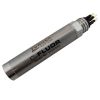Turner Designs DataBank Handheld Data Logger
Features
- Stores up to 9,999 records and 16 calibrations
- Simplifies sensor calibration & includes auto-gain function
- Now includes integrated GPS standard with the purchase
- Free ground shipping
- Expedited repair and warranty service
- Lifetime technical support
- More
Overview
The Turner Designs DataBank is a universal meter, data logger, & power supply. Data can be stored and downloaded to a PC. Sensor calibration is simplified through continuous sensor readings with results graphically displayed. Sensor power is provided directly from the DataBank, which is powered by internal rechargeable batteries, an external 9-30VDC power source, or AC power.
GPS Data
GPS data are integrated into the DataBank. Each line of data that is stored or exported contains time, date, and position information, as well as the sample measurement. The Turner Designs DataBank is ideal for conducting dye trace studies, mapping algal blooms or looking for the presence of optical brighteners as an indicator of wastewater contamination.
- (1) DataBank data logger with rechargeable NiMH batteries
- (1) PC/Power USB interface cable
- (1) AC to DC charger supply
- (1) USB Drive with Software
In The News
Cal Poly, San Luis Obispo Manages Monitoring Efforts in Morro Bay
California Polytechnic State University, San Luis Obispo (Cal Poly, SLO), has been monitoring Morro Bay for decades, and while the monitoring program has changed over the years, the dedication to monitoring the bay has remained the same. The project started in 2006 as a Packard Foundation-funded initiative to monitor water quality flowing in and out of Morro Bay. The goal at the time was to use the data collected to develop and inform an ecosystem-based management plan in collaboration with the Morro Bay National Estuary Program (MBNEP). Since the estuary was the focus at the time, researchers were monitoring water flowing into the estuary from Chorro Creek and Los Osos Creek.
Read MoreGreen Water in Green Bay: Using Data Buoys to Monitor the Southern Bay
While the bay of Green Bay has been referred to as the largest freshwater “estuary” in the world, the watershed hosts intensive agriculture and contributes one-third of Lake Michigan’s total phosphorus load. The Fox River flows into the bay, carrying excess nutrients largely the result of non-point source runoff from the watershed. With a history of deterioration extending well into the last century, the bay ecosystem suffered significant declines in water quality. This, in turn, stimulated major clean-up and ongoing restoration efforts to improve water quality. Tracking these changes is an important aspect of ecosystem management.
Read MoreCross-Border Sewage Contaminated Flows: Monitoring the Tijuana River
The Tijuana River runs across the US-Mexico boundary, flowing into and throughout southern California, carrying with it nutrients and contaminants throughout the estuary. In recent decades, the flows have been heavily polluted with untreated sewage from the City of Tijuana. The wastewater enters the greater Tijuana River estuary, impacting coastal communities and disrupting the natural environment. In order to better understand these cross-border flows, researchers out of San Diego University sought to monitor the waterway test the capabilities of in-situ sensors to measure the contaminated water. Natalie Mladenov and Trent Biggs were two of the researchers involved in the project, deploying a real-time monitoring system in May of 2021.
Read More






























